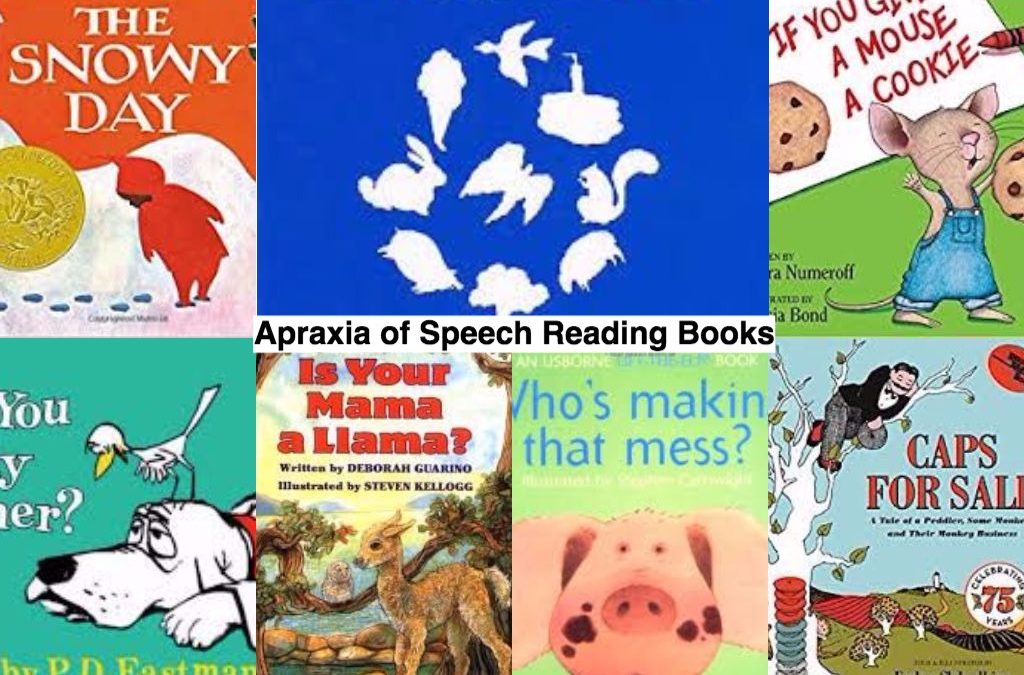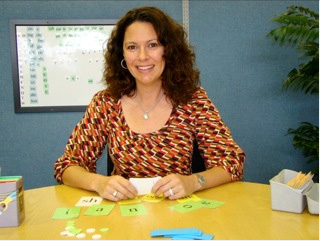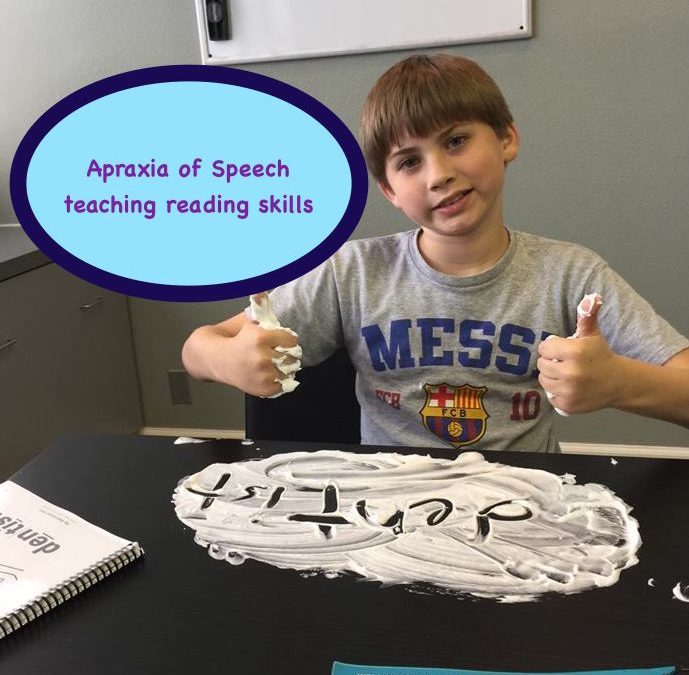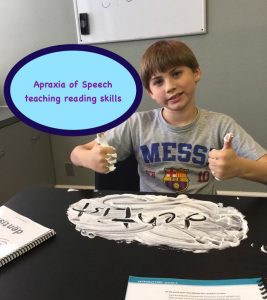
by PRIDE Reading Program Admin | Nov 8, 2017 | A PRIDE Post, Apraxia of Speech

Reading is an excellent tool in helping kids with apraxia of speech find their voice. Kids love reading books that are colorful, predictable and highly repetitive. For kids with apraxia of speech this repetition is crucial.
Repetitive books help kids with apraxia of speech grasp the content of the story much easier. When kids have less to think about, they can have fun and relax in the story. It also allows the child to repeat the language over and over again, getting comfortable with the words and sentences and looking forward to filling in the blanks with new words that really capture their attention. Kids LOVE reading the same books over and over again and that is a really good thing for children with Apraxia of Speech.
Here are a few of my favorite books to read with kids that have Apraxia of Speech. If you would like to purchase any of these books, I have included links:
- Blue Hat, Green Hat (Boynton, S.)
- Goodnight Moon (Brown, M.)
- Dear Zoo: A Lift The Flap Book (Campbell, R.)
- Have You Seen My Cat? (Carle, E.)
- 1, 2, 3 to the Zoo (Carle, E.)
- Jesse Bear, What Will You Wear? (Carlstrom, N.W.)
- Who’s Making That Mess? (Cartwright, S.)
- Five Little Monkeys Jumping on the Bed (Christelow, E.)
- Are You My Mother? (Eastman, P.D.)
- Green Eggs and Ham (Eastman, P.D.)
- Go Dog, Go! (Eastman, P.D.)
- Up to Ten and Down Again (Ernst, L.C.)
- Is Your Mama A Llama? (Guarino, D.)
- Jump, Frog, Jump! (Kalan, R.)
- The Snowy Day (Keats, E.)
- Brown Bear, Brown Bear, What Do You See? (Martin, B.)
- If You Give A Mouse A Cookie (Numeroff, L.)
- A Bubble (Pereira, L.)
- The Big Book of Exclamations! (Peterson, T.K.)
- It Looked Like Spilt Milk (Shaw, C.B.)
- Sheep In A Jeep (Shaw, N.)
- Caps For Sale (Slobodkina, E.)
- Hi, Pizza Man (Walter, Virginia)
- “Buzz, Buzz, Buzz” Went Bumblebee (West, C.)
- I Don’t Care! Said the Bear (West, C.)
- I Went Walking (Williams, S.)
- The Little Old Lady Who Was Not Afraid of Anything (Williams, L.)
- The Napping House (Wood, A.)
When reading these highly repetitive and predictable books with your child, keep in mind that a child with Apraxia of Speech will need just a little extra time to fill in those repetitive and highly predictable phrases. Remember, it is hard for them and it’s so important to keep patient and keep it fun!

Karina Richland, M.A., is the Executive Director of PRIDE Learning Centers, LLC, an educational company that works with children in special education and focuses on reading, writing and comprehension help. She is also the author of the PRIDE Reading Program, a multisensory Orton-Gillingham reading, writing and comprehension curriculum that is available worldwide for parents, tutors, teachers and homeschoolers of struggling readers.
Karina has an extensive background in working with students of all ages and various learning modalities. She has spent many years researching learning differences and differentiated teaching practices. You can reach her at info@pridelearningcenter.com

by PRIDE Reading Program Admin | Aug 29, 2017 | A PRIDE Post, Apraxia of Speech
Apraxia of Speech is a speech disorder that makes it difficult for children to correctly pronounce syllables and words. When a child struggles with saying the sounds, they simultaneously struggle with reading, writing and comprehending the sounds.
To read proficiently, a child requires highly integrated skills in word decoding and comprehension and draws upon basic language knowledge such as semantics, syntax, and phonology. Children with speech and language impairments, such as Childhood Apraxia of Speech (CAS), have deficits in phonological processing. For these children, phonemic awareness, motor program execution, syntax and morphology will interfere with the ability to acquire the skills necessary to become proficient readers.
So… how does a child with Apraxia of Speech learn how to read?
With a multisensory, structured, systematic, cumulative and repetitive reading program plus intensive therapy in phonemic awareness and phonological processing!
What does multi-sensory mean?
See it – Say it – Move with it – Touch it!
Multisensory teaching is an important aspect of instruction for the child with Apraxia of Speech and is used by most clinically trained therapists. Multisensory teaching utilizes all the senses to relay information to the child. The teacher accesses the auditory, visual, and kinesthetic pathways in order to enhance memory and learning. Links are consistently made between the visual (language we see), auditory (language we hear), and kinesthetic-tactile (language we feel) pathways in learning to read. For example, when learning the letter combination “ong” the child might first look at it and then have to trace the letters in the air while speaking out loud. This combination of listening, looking, and moving around creates a lasting impression for the child as things will connect to each other and become memorable.
What is a structured, systematic, cumulative and repetitive reading program?
The Orton-Gillingham approach is the best!
The most significant component in helping a child with Apraxia of Speech learn to read is utilizing an Orton-Gillingham approach. In Orton-Gillingham, the phonemes are introduced in a systematic, sequential and cumulative process. The Orton-Gillingham teacher begins with the most basic elements of the English language. Using repetition and the sequential building blocks of our language, phonemes are taught one at a time. This includes the consonants and sounds of the consonants. By presenting one rule at a time and practicing it until the child can apply it with automaticity and fluency, the child will have no reading gaps in their word-decoding skills. As the child progresses to short vowels, he or she begins reading and writing sounds in isolation. From there the child progresses to digraphs, blends and diphthongs.
Children are taught how to listen to words or syllables and break them into individual phonemes. They also take individual sounds and blend them into a word, change the sounds in the words, delete sounds, and compare sounds. For example, “…in the word bread, what is the first sound you hear? What is the vowel sound you hear? What is the last sound you hear? Students are also taught to recognize and manipulate these sounds. “…what sound does the ‘ea’ make in the word bread? Say bread. Say bread again but instead of the ‘br’ say ‘h.’- HEAD!
Every lesson the child learns is in a structured and orderly fashion. The child is taught a skill and doesn’t progress to the next skill until the current lesson is mastered. As children learn new material, they continue to review old material until it is stored into the child’s long-term memory. While learning these skills, the child focuses on phonemic awareness. There are 181 phonemes or rules in Orton-Gillingham for students to learn. More advanced readers (middle school) will study the rules of English language, syllable patterns, and how to use roots, prefixes, and suffixes to study words. By teaching how to combine the individual letters or sounds and put them together to form words and how to break longer words into smaller pieces, both synthetic and analytic phonics are taught throughout the entire Orton-Gillingham program.
What is Phonological Processing?
The key to the entire reading process is phonological awareness. This is where a child identifies the different sounds that make words and associates these sounds with written words. A child cannot learn to read without this skill. In order to learn to read, children must be aware and able to sound out each of the phonemes in the English language. A phoneme is the smallest functional unit of sound. For example, the word ‘bench’ contains 4 different phonemes. They are ‘b’ ‘e’ ‘n’ and ‘ch.’
What are some activities in phonological awareness that help?
- Identifying rhymes – “Tell me all of the words you know that rhyme with the word BAT.”
- Segmenting words into smaller units, such as syllables and sounds, by counting them. “How many sounds do you hear in the word CAKE?”
- Blending separated sounds into words – “What word would we have if we blended these sounds together: /h/ /a/ /t/?”
- Manipulating sounds in words by adding, deleting or substituting – “In the word LAND, change the /L/ to /B/.” “What word is left if you take the /H/ away from the word HAT?”
Through phonological awareness, children learn to associate sounds and create links to word recognition and decoding skills necessary for reading. Research clearly shows that phoneme awareness performance is a strong predictor of long- term reading and spelling success for children with speech and language disabilities. In fact, according to the International Reading Association, phonemic awareness abilities in kindergarten (or in that age range) appear to be the best single predictor of successful reading acquisition!

What kind of reading intervention is necessary?
For the child diagnosed with Apraxia of Speech that is already behind his peers in phonemic awareness and reading, the instruction will need to be delivered with great intensity. Keep in mind that this child is behind his classmates and must make more progress if he is to ever catch up. The rest of the class does not stand still to wait, they continue forward. Taking a few lessons once or twice a week will never give the student with CAS the opportunity to catch up. He must make a giant leap; if not, he will always remain behind.
An older child with a speech and language disorder may require as much as 150 to 300 hours of intensive instruction if he or she is ever going to close the reading gap between himself and his peers. The longer identification and effective reading instruction are delayed, the longer the child will need to catch up. In general, it takes 100 hours of intensive instruction to progress one year in reading level. The sooner this remediation is completed, the sooner the child can progress forward with his or her peers.
Children with Apraxia of Speech need more structure, repetition and differentiation in their reading instruction. They need to learn basic language sounds and the letters that make them, starting from the very beginning and moving forward in a gradual step by step process. This needs to be delivered in a systematic, sequential and cumulative approach. For all of this to “stick” the children will need to do this by using their eyes, ears, voices, and hands.
Where do I find an Orton-Gillingham Reading Curriculum?
Click on the video below
If you enjoyed reading this Blog Post, you might also enjoy reading Apraxia of Speech Reading Books. Thank you so much for visiting my blog today!

Karina Richland, M.A., developed the PRIDE Reading Program, an Orton-Gillingham program for struggling readers, based on her extensive experience working with children with learning differences over the past 30 years. She has been a teacher, educational consultant and the Executive Director of PRIDE Learning Centers in Southern California. Please feel free to email her with any questions at info@pridelearningcenter.com. Visit the PRIDE Reading Program website at https://www.pridereadingprogram.com

by PRIDE Reading Program Admin | Apr 10, 2017 | Apraxia of Speech, Speech and Reading
Reading is a fundamental skill needed for academic success. In today’s world, strong literacy skills are essential. Children who struggle in reading tend to experience extreme difficulties in all content areas, as every subject in school requires reading proficiency. When children are then faced with further struggles such as Speech Apraxia and receptive and expressive language difficulties, the effects can be even more detrimental.
To read proficiently, a child requires highly integrated skills in word decoding and comprehension and draws upon basic language knowledge such as semantics, syntax, and phonology. Children with speech and language impairments, such as Speech Apraxia, have deficits in phonological processing. For these children, phonemic awareness, motor program execution, syntax and morphology will interfere with the ability to acquire the skills necessary to become proficient readers.
So, how does a child with Speech Apraxia learn how to read?
– With a multisensory, structured, systematic, cumulative and repetitive reading program plus intensive therapy in phonemic awareness and phonological processing!
What is multisensory teaching?
Multisensory teaching is an important aspect of instruction for the child with Speech Apraxia and is used by most clinically trained therapists. Multisensory teaching utilizes all the senses to relay information to the child. The teacher accesses the auditory, visual, and kinesthetic pathways in order to enhance memory and learning. Links are consistently made between the visual (language we see), auditory (language we hear), and kinesthetic-tactile (language we feel) pathways in learning to read. For example, when learning the letter combination “ong” the child might first look at it and then have to trace the letters in the air while speaking out loud. This combination of listening, looking, and moving around creates a lasting impression for the child as things will connect to each other and become memorable.
What is a structured, systematic, cumulative and repetitive reading program?
The other significant component in helping a child with Speech Apraxia learn to read is utilizing an Orton-Gillingham approach. In Orton-Gillingham, the phonemes are introduced in a systematic, sequential and cumulative process. The Orton-Gillingham teacher begins with the most basic elements of the English language. Using repetition and the sequential building blocks of our language, phonemes are taught one at a time. This includes the consonants and sounds of the consonants. By presenting one rule at a time and practicing it until the child can apply it with automaticity and fluency, the child will have no reading gaps in their word-decoding skills. As the child progresses to short vowels, he or she begins reading and writing sounds in isolation. From there the child progresses to digraphs, blends and diphthongs.
Children are taught how to listen to words or syllables and break them into individual phonemes. They also take individual sounds and blend them into a word, change the sounds in the words, delete sounds, and compare sounds. For example, “…in the word bread, what is the first sound you hear? What is the vowel sound you hear? What is the last sound you hear? Students are also taught to recognize and manipulate these sounds. “…what sound does the ‘ea’ make in the word bread? Say bread. Say bread again but instead of the ‘br’ say ‘h.’- HEAD!
Every lesson the child learns is in a structured and orderly fashion. The child is taught a skill and doesn’t progress to the next skill until the current lesson is mastered. As children learn new material, they continue to review old material until it is stored into the child’s long-term memory. While learning these skills, the child focuses on phonemic awareness. There are 181 phonemes or rules in Orton-Gillingham for students to learn. More advanced readers (middle school) will study the rules of English language, syllable patterns, and how to use roots, prefixes, and suffixes to study words. By teaching how to combine the individual letters or sounds and put them together to form words and how to break longer words into smaller pieces, both synthetic and analytic phonics are taught throughout the entire Orton-Gillingham program.
What is phonological processing?
The key to the entire reading process is phonological awareness. This is where a child identifies the different sounds that make words and associates these sounds with written words. A child cannot learn to read without this skill. In order to learn to read, children must be aware of phonemes. A phoneme is the smallest functional unit of sound. For example, the word ‘bench’ contains 4 different phonemes. They are ‘b’ ‘e’ ‘n’ and ‘ch.’
Some examples of phonological awareness tasks include:
- Identifying rhymes – “Tell me all of the words you know that rhyme with the word BAT.”
- Segmenting words into smaller units, such as syllables and sounds, by counting them. “How many sounds do you hear in the word CAKE?”
- Blending separated sounds into words – “What word would we have if we blended these sounds together: /h/ /a/ /t/?”
- Manipulating sounds in words by adding, deleting or substituting – “In the word LAND, change the /L/ to /B/.” “What word is left if you take the /H/ away from the word HAT?”
Through phonological awareness, children learn to associate sounds and create links to word recognition and decoding skills necessary for reading. Research clearly shows that phoneme awareness performance is a strong predictor of long- term reading and spelling success for children with speech and language disabilities. In fact, according to the International Reading Association, phonemic awareness abilities in kindergarten (or in that age range) appear to be the best single predictor of successful reading acquisition!
What kind of reading intervention is necessary?
For the child diagnosed with Speech Apraxia that is already behind his peers in phonemic awareness and reading, the instruction will need to be delivered with great intensity. Keep in mind that this child is behind his classmates and must make more progress if he is to ever catch up. The rest of the class does not stand still to wait, they continue forward. Taking a few lessons once or twice a week will never give the student with Apraxia of Speech the opportunity to catch up. He must make a giant leap; if not, he will always remain behind.
A child with a speech and language disorder may require as much as 150 to 300 hours of intensive instruction if he is ever going to close the reading gap between himself and his peers. The longer identification and effective reading instruction are delayed, the longer the child will need to catch up. In general, it takes 100 hours of intensive instruction to progress one year in reading level. The sooner this remediation is completed, the sooner the child can progress forward with his peers.
Children with Speech Apraxia need more structure, repetition and differentiation in their reading instruction. They need to learn basic language sounds and the letters that make them, starting from the very beginning and moving forward in a gradual step by step process. This needs to be delivered in a systematic, sequential and cumulative approach. For all of this to “stick” the children will need to do this by using their eyes, ears, voices, and hands.
Learn more about the New PRIDE Reading Program
___________________________________________________________________________________________________

Karina Richland, M.A. is the Founder of PRIDE Learning Centers, located in Southern California. Ms. Richland is a certified reading and learning disability specialist. She speaks frequently to parents, teachers, and professionals on learning differences, and writes for several journals and publications. You can visit the PRIDE Learning Center website at: www.pridelearningcenter.com







